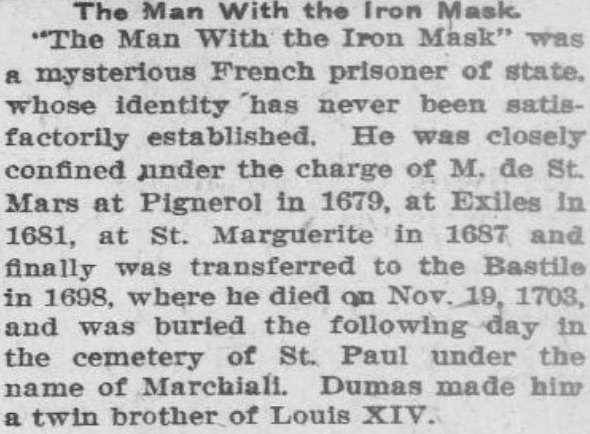
Was James de la Cloche, known as Abbe Pregnani, the man in the iron mask? There are many theories as to who wore the mask and this is just one of them.
This article was originally published in 1920.

Iron Mask Man Identified as Abbe Pregnani
Further evidence pointing toward the identity of the Man in the Iron Mask has been unearthed recently in France. According to Dame Rumor, the popular theory that this famous political prisoner of Louis XIV was James de la Cloche, alias the Abbe Pregnani, has been confirmed. The mystery of the Man in the Iron Mask has been puzzling the world for over two hundred years.
Theories, practical and extreme, have been propounded and discarded upon the discovery of new evidence.
The Man in the Iron Mask did not wear an iron mask, according to the popular legend, but his face was covered with a mask of black velvet. He was brought to the Bastile on Sept. 18, 1698, by M. de Saint-Mars, the new governor, from the fortress of the Isles Ste. Marguerite. The prisoner had been in his keeping for many years.
The wearer of the mask was kept apart from the other prisoners, with special keepers guarding him. He was not permitted to speak or remove his mask under penalty of death. Even when he fell ill and was attended by a doctor his face remained masked and M. de Saint-Mars stood over him lest he speak.
Death is Recorded
In the journal of Etienne du Junca, one of the king’s lieutenants in the Bastille, there is an account of this mysterious prisoner’s death after thirty-three years of imprisonment, saying:
“On Monday, the 19 of November, 1703, the unknown prisoner, always masked with a black velvet mask, whom M. de Saint-Mars had brought with him from the Isles Ste. Marguerite and had kept for a long time. . . died at about 10 o’clock this evening.”
There is a later entry describing the burial of the prisoner on the 20th in the prison cemetery of St. Paul, and a marginal note revealing the man’s name as “M. de Marchiel, about 45.” After the burial the governor personally supervised the destruction of all paper, furniture and clothing used by the prisoner. Even the walls of his cell were scraped to obliterate any hidden message that might have been written on the stone.
But who was the Man in the Iron Mask?
Which is the correct theory?
In 1711 Princess Palatine wrote to Electress Sophia of Hanover and suggested that the mysterious man might be an English nobleman who disappeared after being involved in the Duke of Berwick’s plot against William III. Voltaire described the man in the Iron Mask as the son of Mazarin and Anne of Austria.
Alexander Dumas, in his book “Vi comte de Bragelonne” exploited the legend that the prisoner was none other than the twin brother of Louis XIV. Each twin would have had half a right to the throne, so Anne of Austria was forced to settle the controversy that would ultimately arise by disposing of one of the twins during their infancy.
Many who believed the prisoner was a member of the royal house claim that his son settled in Corsica under the name of De Bouna Parte and was the ancestor of Napoleon.
Two Logical Situations
Modern criticism of the many theories has narrowed the puzzling issue to two stories which have been frequently corroborated by historical fact.
The first is the Mattioli theory. It is believed by some that Ercole Antonio Mattioli, a Minister of Charles IV, Duke of Mantu, was the Man in the Iron Mask. History tells us that Mattioli sold the plans of the fortress of Casale to Louis XIV, and upon the occupation of the fortress by the French he betrayed the transactions to Austria, Spain, Venice and Savoy. In revenge Louis had him kidnapped and it is said he was wearing a mask when arrested. Louis decided to make him wear the mask for life. It was reported in 1680 that Mattioli, now a prisoner of Saint-Mars in the Isles Ste. Marguerite, was almost mad, due to his solitary confinement.
The other popular version is that the prisoner was Eustache Dauger, a valet of Lauzin, who was a friend of Fouquet, the King’s political enemy. It is thought that he was imprisoned because he knew too much for the safety of the empire.
Maurice Le Blanc, in his story of “The Hollow Needle” uses the story of the valet who pried into a secret communication and had to be imprisoned because of his dangerous knowledge of state affairs. Andrew Lang propounded the theory in his book “The Valet’s Tragedy” that Dauger was a French Huguenot, Roux de Marsilly, a name similar to that of the man who died in the Bastille, who was a secret agent for the Protestants in France. He was captured in Switzerland and reported executed, but it is believed he was taken to the Isles of Ste. Marguerite.
Son of Charles II Old Theory
The latest evidence recalls the old theory that Dauger was James de la Cloche, the natural son of Charles II of England. He frequently acted as messenger to the Abbe Pregnani. On one of these trips Charles II believed he was betrayed by his son and asked Louis XIV to imprison him because he knew too much about their negotiations.
Source: The Bridgeport times and evening farmer. (Bridgeport, Conn.), 24 Sept. 1920.

